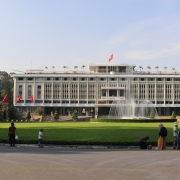What started the Second Indochina War?
Topic of Study [For H2 History Students]:
Paper 1: Understanding the Cold War (1945-1991)
Section A: Source-based Case Study
Theme I Chapter 2: A World Divided by the Cold War – Manifestations of the global Cold War: Vietnam War (1955-75)
Topic of Study [For H1 History Students]:
Essay Questions
Theme II Chapter 2: The Cold War and Southeast Asia (1945-1991): The Second Indochina War (1964-1975)
Historical Context: Battles in Indochina
Before we examine the Second Indochina War, which is commonly known as the ‘Vietnam War’, it is imperative to understand the historical developments in the Indochinese region.
Ever since 1887, Vietnam was under French colonial occupation until World War Two. Following the end of the Japanese Occupation, the French returned to Vietnam.
1a. First Indochina War (1945-1954)
In contrast to the pre-WWII phase, Vietnam engaged in a serious of fierce military confrontation with the French. This conflict was known as the ‘First Indochina War’. Eventually, after the historic ‘battle of Điện Biên Phủ‘, the French was defeated. At the same time, the Geneva Accords were signed during the Geneva Peace Conference, which signified the withdrawal of the French from the Indochinese region.
During the First Indochina War, the French formed a local government led by Bảo Đại, who was a self-exiled former emperor. In early 1954, Bảo Đại was replaced by Ngo Dinh Diem as the prime minister.
1b. The Great Divide: 17th parallel
The provisions of the Accords included the division of Vietnam along the 17th parallel. The northern part was known as the Democratic Republic of Vietnam (DRV) led by Ho Chi Minh. The southern region below the 17th parallel is called the Republic of Vietnam (RoV) under Emperor Bảo Đại.
Although the partition was carried out with the aim of facilitating a ceasefire after the 1954 conflicts, tensions mounted and manifested in the form of actual fighting again. Furthermore, the South was unwilling to participate in the 1956 elections.
More importantly, the North and South were largely influenced by Cold War rivals, which later shaped the developments of the next major conflict.
2a. Second Indochina War (1954-1974)
In South Vietnam, Diem deposed Bảo Đại and became the next president. Notably, Diem was a viable anti-communist leader that aligned with the Cold War interests of USA.
Following the Cuban Missile Crisis, the Kennedy Administration intensified its efforts in supporting the Diem regime to stem communist expansion in Indochina. One clear evidence is the increased presence of American military advisers deployed in the South.
In the North, Ho Chi Minh’s DRV expanded its military might with the help of external powers, such as the People’s Republic of China (PRC) and the Soviet Union. Furthermore, Ho rallied the peasants to support his nationalistic cause.
2b. A Test of Loyalty: Sino-Soviet split
Ever since the controversial ‘Secret Speech‘ by Soviet leader Khrushchev in April 1956, USSR was at odds with PRC due to ideological differences and personality clashes.
As such, both Communist powers competed to gain the trust of North Vietnam through the provision of military and economic support. From 1964 to 1969, the PRC aided the North with the condition that their recipient reject support from Soviet Union.
From 1967 onwards, Soviet Union increased their support for the North. Similar to Kennedy’s approach, Soviet advisors entered the fray and aided the North. Also, military support was granted to improve their chances of victory. Notably, more than 75% of North Vietnam’s military capabilities originated from USSR, such as tanks and anti-aircraft guns.
2c. The ‘Americanisation’ of the Vietnam War
After the Tonkin Gulf incident in August 1964, the Lyndon Administration embarked on a large-scale military campaign in Vietnam under the auspices of the Gulf of Tonkin Resolution.
Subsequently, numerous American men were drafted to expand the size of the US military forces. The drafting process was challenging as some of the students aged 18 to 25 in the USA protested openly.
Furthermore, the US government launched ‘Operation Rolling Thunder‘ in March 1965, which involved a prolonged period of aerial bombing. Its purpose was to display American air superiority and demoralise the North forces.
What can we learn from this article?
Consider the following question:
– How far do you agree that Second Indochina War broke out due to ideological differences? [to be discussed in class].
Now that you have covered the key events and players that explained the Second Indochina War, you should apply your knowledge to essay practice questions. Alternatively, you can sign up for our JC History Tuition. You will receive concise study notes and engage in enriching thematic discussions to be more ready for the GCE A Level History examinations.
The H2 and H1 History Tuition feature online discussion and writing practices to enhance your knowledge application skills. Get useful study notes and clarify your doubts on the subject with the tutor. You can also follow our Telegram Channel to get useful updates.
We have other JC tuition classes, such as JC Math Tuition and JC Chemistry Tuition. For Secondary Tuition, we provide Secondary English Tuition, Secondary Math tuition, Secondary Chemistry Tuition, Social Studies Tuition, Geography, History Tuition and Secondary Economics Tuition. For Primary Tuition, we have Primary English, Math and Science Tuition. Call 9658 5789 to find out more.




